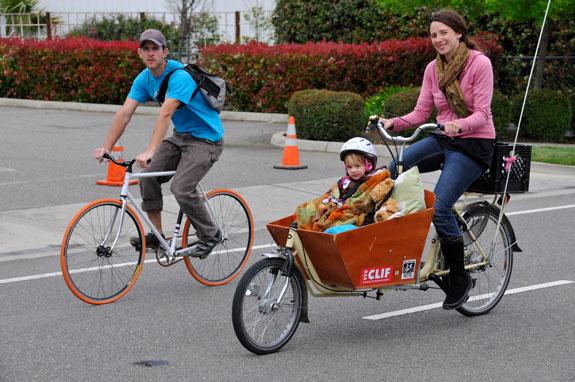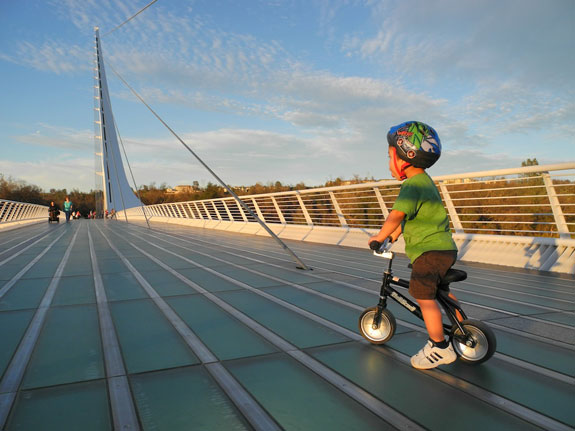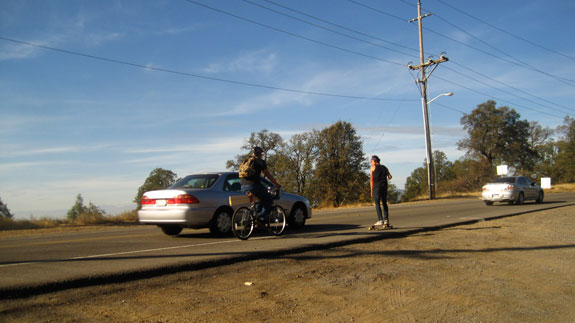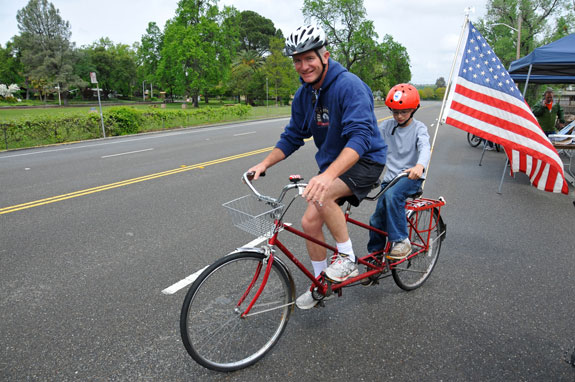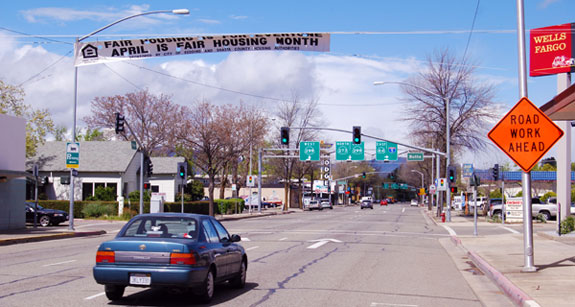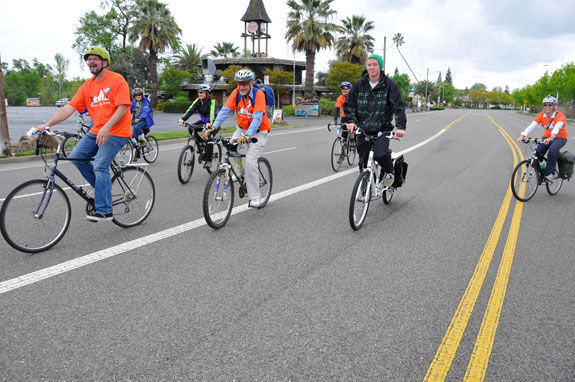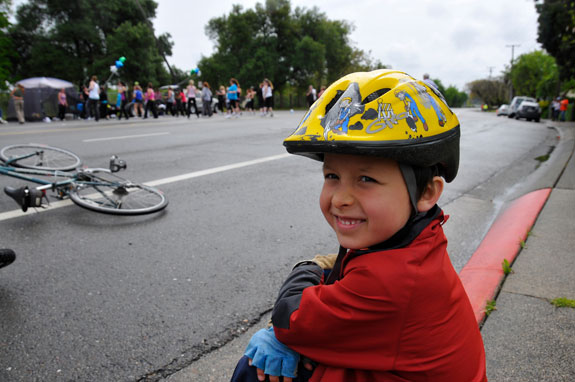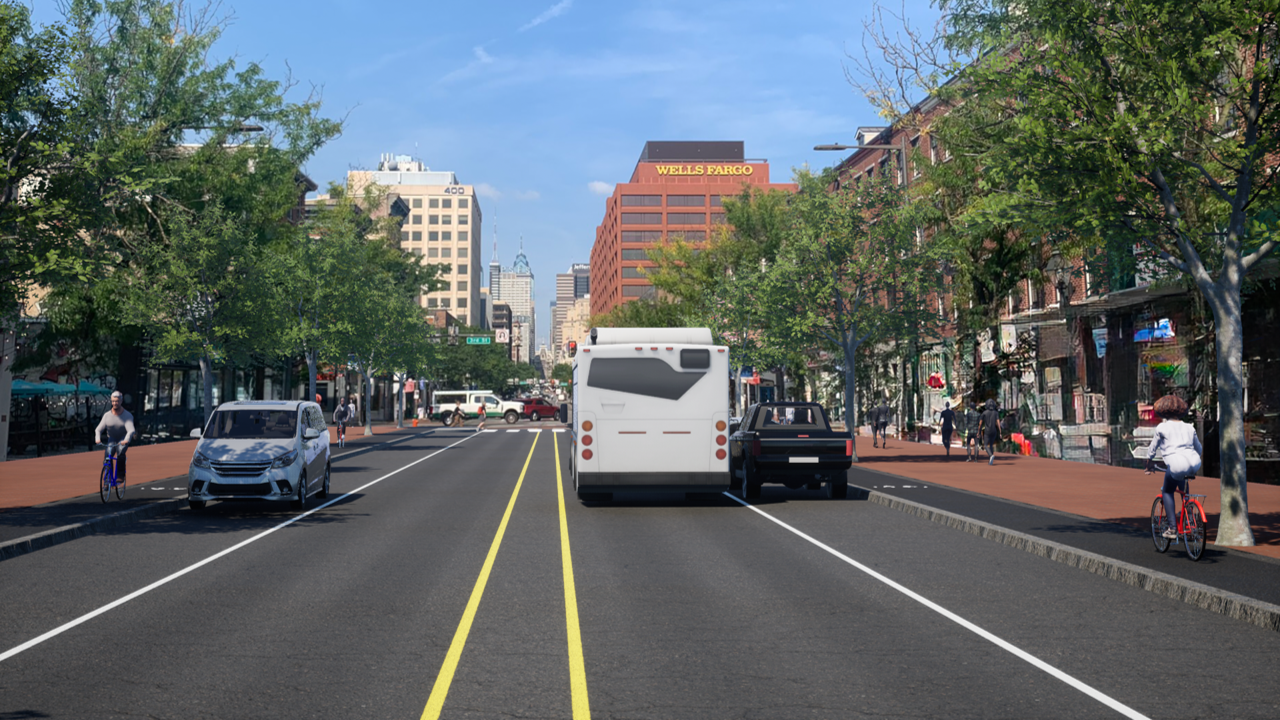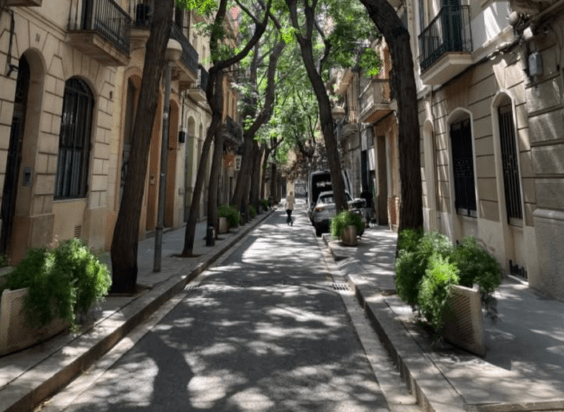Redding, California, with a population of 90,000, is probably best known for its sunshine, breathtaking landscapes and conservative politics. Located 200 miles north of Sacramento in Shasta County, the lush region surrounded by the Trinity and Cascade mountains offers an abundance of recreation, including a growing number of paved multi-use trails that draw large crowds of bicyclists and pedestrians.
The seven-year-old Sundial Bridge, a 700-foot long steel marvel on the Sacramento River designed by the Spanish architect Santiago Calatrava, has become Redding's living room.
"It is where everyone hangs out in town, especially when the weather is nice. In a normal community, whatever normal is, you would see that sort of energy in a downtown square, or park, or even a downtown third place, but it happens to be out at the Sundial Bridge," said Paul Shigley, the senior editor of the California Planning and Development Report (CP&DR), who lives six miles west of Redding near Whiskeytown Lake.
Downtown Redding does not draw a similar convergence of people enjoying public space because like many California cities it was designed for the automobile, and is not a particularly welcoming place for pedestrians and bicyclists. The city ranks 40th among 103 cities in California "for the number of pedestrian collisions by population," according to a recent report [pdf]. Just last week, a 16-year-old boy was struck and killed by a driver while walking across a bridge that lacked a sidewalk.
"The town is set up to conduct motorists fast and to allow them to drive up to 50, 60 miles an hour right through the middle of town," said Scott Mobley, a reporter for the Record Searchlight, the city's daily newspaper.
"It's dangerous," said Anne Wallach Thomas, a former San Francisco resident and bicyclist who helped found the Shasta Cascade Bicycle Coalition. "Some people are lucky and they can go around some little side streets, and if you're not lucky like me, I can't ride my bicycle to my sister's house, I can't ride to the grocery store."
In the late 1970s, the city made a poor planning decision to build a mall in the center of town and designed a network of one-way arterial streets. The mall failed not long after it opened, becoming what CP&DR described as "a glum collection of offices, struggling shops and vacant space."
"Downtown has been pretty much a dead zone for decades. There are areas that have signs of life but the big problem is very few people live downtown," said Shigley, who a few years ago in CP&DR named Redding one of California's most disappointing mid-sized cities. But "check back in 10 years," the report added.
The Demand
Judging from the crowds of bicyclists and walkers who show up to enjoy the region's vast network of scenic trails, there is an increasing demand for bicycle facilities and better conditions for pedestrians. Like the Sundial Bridge, Shigley said weekend crowds pack the one-mile Dana to Downtown bikeway and walking path recently constructed by Caltrans as part of a Highway 44 bridge improvement and widening project.
"It goes from the Dana Drive big box area over to the convention center area, and it's proven wildly popular that you can get to those two parts of town on foot and on bike," said Shigley.
"The reason people live up here primarily is because it's really beautiful. We have access to amazing recreation opportunities. So lots of people have multiple $1500 bikes in their garages. They put them on the car and drive some miles to get on a trail," said Wallach Thomas.
Driving to one of the region's popular riverfront trails might be an easy venture, but try walking and bicycling there and the conditions can be treacherous. The region's bike network lacks good connectivity to major destinations. That doesn't mean, however, that bicyclists are staying off the streets. Bicycle traffic counts taken last September by Redding's Bicycle Advisory Committee and Healthy Shasta showed a dramatic 80 percent increase in riders at major intersections.
"I have no trouble being a cyclist here. I've been doing it for 10 years," said Mobley, the newspaper reporter, who is an everyday bicyclist. He thinks many drivers are beginning to adjust to having more bicyclists on the streets.
"It's been years since someone's called me an idiot or flipped me off or gunned their engine as they go by just to intimate me. I mean, that's happened to me but not in a long time," said Mobley.
Although he finds it easier to bike, Mobley pointed out that a friend, who is also a regular cyclist, got run off the road last year by a driver who "literally came right up behind him and made damn sure he was in a ditch. He hurt himself. Ripped open his knee and was quite debilitated after that."
Many cyclists are forced onto the shoulders of roads, if there are any, or the sidewalk, where it is legal to ride in Redding.
"On many days while attending Shasta High School I rode my bike several miles a day to and from school. Redding has always offered so many ways to enjoy the outdoors and now has great bike facilities along the river and so much potential for more," said Jim Brown of the California Bicycle Coalition.
Changing Hearts and Minds
Advocates say the popularity of Redding's biking and walking trails, along with a desire to get healthy are indeed causing more people to second guess their traditional mode of transportation. According to the Shasta Coalition for Activity and Nutrition, 66 percent of adults in Shasta County are overweight, along with 27 percent of teens.
"You start off maybe riding your bike for entertainment on the river trail and then you think, 'wow, maybe I could ride my bike to work,' 'maybe I could ride to the store, 'maybe I could ride my kids to school everyday,'" said Francie Sullivan, a member of the Redding City Council who is a recreational cyclist.
The five-member council recently began working on a Complete Streets policy and decided to make completing it "our number one priority," said Sullivan, adding that Redding, like other California cities, is grappling with budget woes and 17 percent unemployment. "But the good news about the economy is that more people are walking and riding bikes out of necessity."
Sullivan, a Democrat who has served in public office for more than 20 years, said Shasta County is a "conservative community" but the issue transcends party lines.
"If you go to the river trail I would venture a guess that a majority of the people who cross you on roller blades and their bikes and who are walking and running are conservative Republicans. Everybody wants to be fit and everybody gets the same mood elevation from being outside," said Sullivan.
Challenges
For the first time, Redding has hired a full-time bicycle and pedestrian coordinator who is working on improving the city's bikeway plan, which until recently had not been updated since 1998. Realizing the increasing demand for bicycle facilities, the Bikeway Action Plan [pdf] envisions increasing the current bikeway network from 124 miles to 162 miles to "improve the connections for cyclists to prime destinations."
Changing the culture of old-school traffic engineers who are primarily concerned with moving automobile traffic and adhering to Level of Service (LOS) standards remains a difficult challenge in Redding, like a lot of California cities. Road and highway widenings are popular, while road diets are practically unheard of.
"You feel like you're fighting an uphill battle every time," said Zachary Bonnin, the city's new bike/ped coordinator. "It's a challenge to implement bike stuff."
Bonnin, who grew up in Phoenix and got an environmental science degree at Northwestern Arizona University, also manages the city's transportation system, the Redding Area Bus Authority (RABA), which sees anywhere from 2,000 to 2,400 daily passengers.
"They put me on board to challenge the engineers and to look at every project and to say 'why are we doing it this way' or 'why can't we do it this way' or 'what about bike and ped' access and 'where's our bike lane' and 'why can't we add a sidewalk here?'" he said.
The drafting of the city's Complete Streets policy is also making some of Bonnin's old-school transportation colleagues rethink the way they've designed the streets. The National Association of City Transportation Officials' recent update of its bikeway design standards is also helping.
"They see these things and say 'well, it would cost us more money not to do that now, then to have to deal with it later,'" said Bonnin.
The city is also hoping to incorporate improvements to the pedestrian realm in its Complete Streets policy, including strengthening its Safe Routes to Schools program, developing a pedestrian safety program and Pedestrian Master Plan to implement capital and maintenance projects. A pedestrian safety assessment prepared by transportation consultants Fehr & Peers and Oakland-based Dowling Associates recommends road diets on some downtown streets, along with bulbouts and median refuge islands.
The city's efforts are also being bolstered by a burgeoning group of living streets advocates with ties to San Francisco's bicycle and transit advocacy community who are working to help transform Redding into a more bikeable, walkable community.
Wallach Thomas and some longtime members of the Norcal Bicycle Partnership, Shasta Wheelmen, the Redding Mountain Biking club and some other bicyclists recently formed the Shasta Cascade Bicycle Coalition to lobby for better conditions and help educate city planners and the public. The group meets once a month.
"The safe and inviting part is important," Wallach Thomas told the Record Searchlight. "We have world-class facilities for mountain bikes and incredible park trails. What we can't do is leave the house and safely get anywhere."
Shasta Living Streets
Last weekend, after months of planning, discussion and wading through city bureaucracy, Redding held its first ciclovía-style event, Shasta Living Streets, converting a two-mile stretch of Park Marina Drive near the Sacramento River into car-free space for people. It was the first open streets event in Northern California outside of the Bay Area.
"It was a success," said Wallach Thomas, who was the main organizer. While some city bureaucrats had doubts that anyone would show up, Wallach said well over 500 people turned out on a rainy day. It helped that the event was timed with the popular Whole Earth Festival.
"I think it's really going to make a big difference up here changing hearts and minds," said Wallach Thomas. "It has implications and leverage far beyond the five hours of the actual event."
Wallach Thomas got advice from her friend Cheryl Brinkman, a member of the San Francisco Municipal Transportation Agency's Board of Directors who has been involved with San Francisco's Sunday Streets since its inception. Brinkman and her husband Rich Coffin took a trip to Redding to speak to a group of advocates interested in launching Shasta Living Streets.
"Gil Peñalosa, the father of ciclovías, always said that it's not a competition among cities or towns. Every city or town which starts a car-free streets program helps the next city or town start their program. I'm thrilled that Redding had its first car-free event," said Brinkman.
The organizers of the event actually received an email from Peñalosa offering his congratulations, and encouraging them to carry on their work.
"I hope this event will be a means to many great initiatives," Peñalosa wrote. "Living Streets will show residents that streets can be used for more than just moving cars; streets are our largest and most valuable assets, the space the belongs to all, regardless of age, gender, ethnicity, social or economic background."
"As other programs inspired you, now you are inspiring others."
